Rational Numbers Class 7 Worksheet Maths Chapter 1
Q1: True or False
(a) Every natural number is a rational number but every rational number needs not be a natural number
 View Answer
View Answer 
Ans: True
(b) Zero is a rational number.
 View Answer
View Answer 
Ans: True
(c) Every rational number is a whole number.
 View Answer
View Answer 
Ans: False
(d) Two rational numbers with different numerators can't be equal.
 View Answer
View Answer 
Ans: False
(e) Every fraction is a rational number.
 View Answer
View Answer 
Ans: True
(f) Sum of two rational numbers is always a rational number.
 View Answer
View Answer 
Ans: True
(g) The rational number -35 lies to the right of zero on the number line.
 View Answer
View Answer 
Ans: False
(h) Every natural number is a rational number but every rational number need not be a natural number.
 View Answer
View Answer 
Ans: True
(i) 2/4 is equivalent to 4/8
 View Answer
View Answer 
Ans: True
(j) The rational numbers -11,-12 and -78 are on the opposite sides of zero on the number line
 View Answer
View Answer 
Ans: True
Q2: Fill in the Blanks
(a) A rational number p /q is said to be in the lowest form if p and q have no __________.
 View Answer
View Answer 
Ans: common factor
(b) The rational numbers -12 and -17 lie to the ____________ of zero on the number line.
 View Answer
View Answer 
Ans: right
(c) If p/q is a rational number, then q can't be ___________.
 View Answer
View Answer 
Ans: 0
(d) Two rational numbers with different numerators are equal, if their numerators are in the same ______________ as their denominators.
 View Answer
View Answer 
Ans: ratio
(e) Two rational numbers are equal if they have the same __________ form.
 View Answer
View Answer 
Ans: simplest
(f) A rational number p/q is negative if p & q are of __________ sign.
 View Answer
View Answer 
Ans: opposite
(g) If the product of two non-zero rational numbers is 1, then they are ______________ of each other.
 View Answer
View Answer 
Ans: reciprocal
(h) Between any two distinct rational numbers there are ___________ rational numbers.
 View Answer
View Answer 
Ans: infinite
(i) Additive inverse of 2/3 is ______.
 View Answer
View Answer 
Ans: -2/3
(j) The reciprocal of ______ does not exist.
 View Answer
View Answer 
Ans: zero
Q3: By what number should we multiply 8/-15 , so that the product is 24.
 View Answer
View Answer 
Ans:
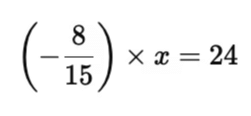
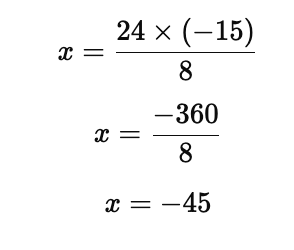
Q4: What should be subtracted from -3/4 to get 5/9?
 View Answer
View Answer 
Ans:  Convert to like denominators
Convert to like denominators

Q5: Subtract -3/8 from -5/7
 View Answer
View Answer 
Ans:
-5/7 - (-3/8) = -5 × 8 + 3 × 756 = -1956
Q6: The cost of 4 1/2 meters of cloth is Rs. 8512. find the cost of one meter cloth.
 View Answer
View Answer 
Ans: Total cost of 4½ meters of cloth = Rs. 8512
Convert the mixed number to an improper fraction= 
Let the cost of 1 meter = x


Q7: Simplify 
 View Answer
View Answer 
Ans: 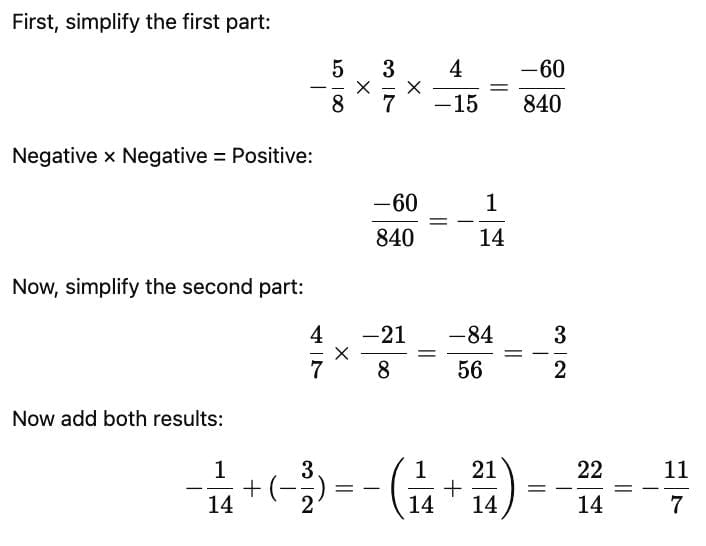 Final Answer:
Final Answer:
Q8: A stairway consists of 14 stairs, each cm high. What is the vertical height of the stairways ?
cm high. What is the vertical height of the stairways ?
 View Answer
View Answer 
Ans: 
Q9: Arrange the rational numbers in the ascending order.
in the ascending order.
 View Answer
View Answer 
Ans: Converting them into same denominator by using LCM
So Ascending order will be
Q10: Which of the following rational numbers is equal to its reciprocal?
(a) 1
(b) 2
(c) 1/2
(d) 0
 View Answer
View Answer 
Ans: (a)
Q11: Which is greater number in the following:
(a) 
(b) 0
(c) 1/5
(d) -5
 View Answer
View Answer 
Ans: (c)
Q12: Which is lowest number in the following:
(a) 
(b) 0
(c) 1/2
(d) -2
 View Answer
View Answer 
Ans: (d)
Q13: Match the Column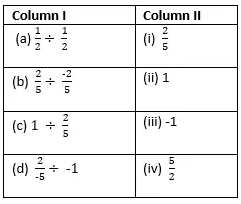
(a) a → ii , b → iii , c → iv , d → i
(b) b → ii , a → iii , c → iv , d → i
(c) a → ii , b → iii , c → i , d → iv
(d) a → i , b → iii , c → iv , d → ii
 View Answer
View Answer 
Ans: (a)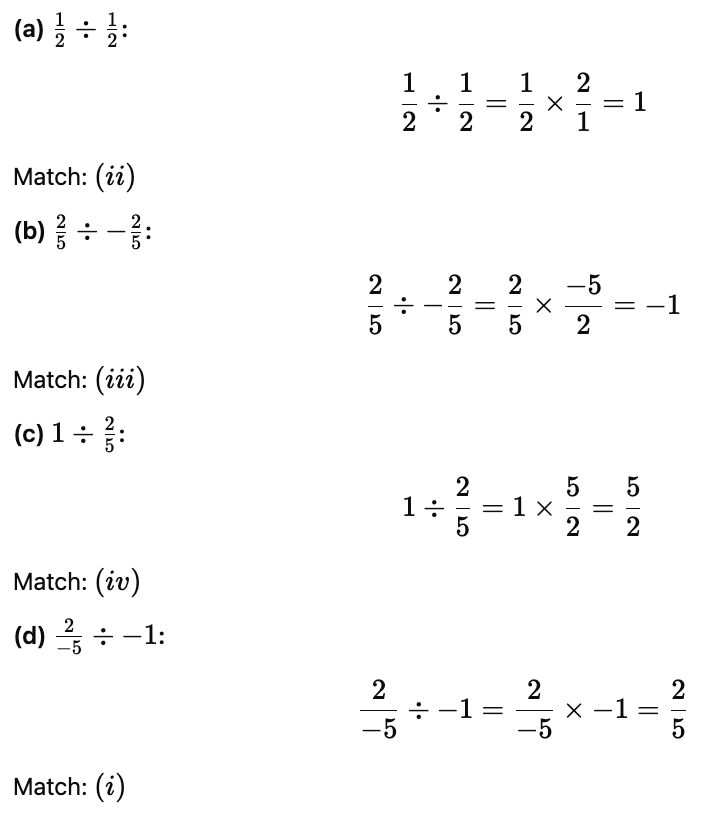
Q14: To reduce a rational number to its standard form, we divide its numerator and denominator by their
(a) LCM
(b) HCF
(c) product
(d) multiple
 View Answer
View Answer 
Ans: (b)
|
76 videos|386 docs|39 tests
|
FAQs on Rational Numbers Class 7 Worksheet Maths Chapter 1
| 1. What are rational numbers and how are they defined? |  |
| 2. How do you identify rational numbers among different types of numbers? |  |
| 3. Can you provide examples of rational numbers in everyday life? |  |
| 4. What operations can be performed on rational numbers? |  |
| 5. How do rational numbers relate to integers and whole numbers? |  |






















